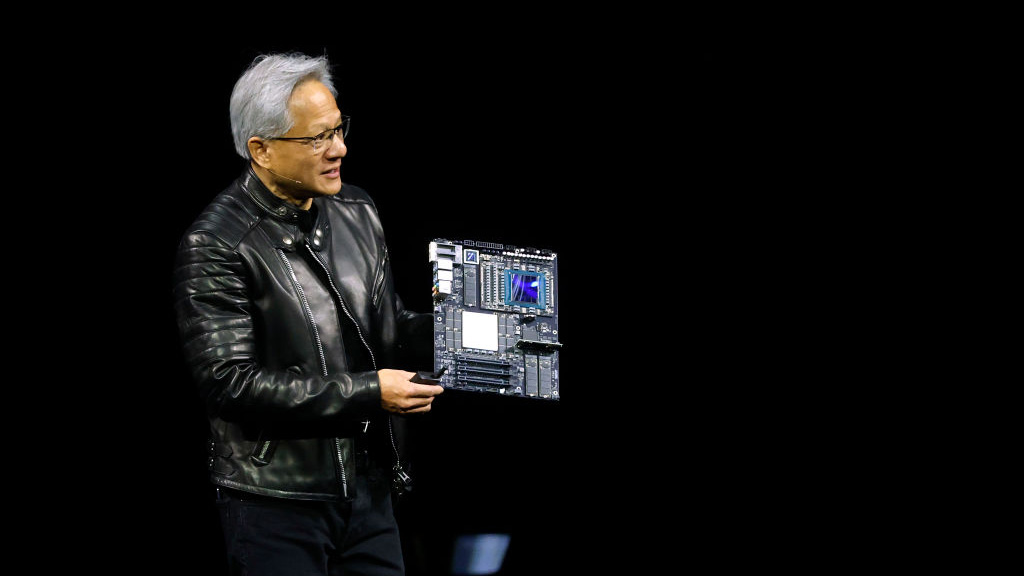Laptop Mag Verdict
The Acer Chromebook 13 is a premium Chrome OS laptop with superfast performance and a sleek aluminum chassis, but those features come at a price.
Pros
- +
Aluminum chassis
- +
Vivid, high-res screen
- +
Great performance
- +
Runs cool
Cons
- -
Below-average battery life for a Chromebook
- -
Poor webcam
- -
Pricey
Why you can trust Laptop Mag
Editor's Note: Acer sent us a replacement Chromebook 13 that has a significantly brighter display than the unit we measured in our original review. We have updated this review accordingly.
Acer has entered the growing premium Chromebook arena with the company's 13.5-inch Chromebook 13 ($699 starting, $799 as reviewed). Appointed to go up against the likes of the Google Pixel Slate and Samsung Chromebook Pro, this business-focused laptop has its work cut out for it.
The Chromebook 13 has several interesting features you don't typically find in a Chromebook. While it doesn't support touch, the Chromebook 13 flaunts a high-res display, and its U-series Intel processors provide excellent performance compared to competing machines.
Not to mention that the Chromebook 13's aluminum chassis feels more premium than the chunky plastic we associate with products running Google's desktop OS. However, a few disappointing shortcomings mean the Chromebook 13 falls just short of greatness.
How much does the Acer Chromebook 13 cost?
The 13.5-inch Chromebook 13 is available in two configurations. The base model costs $699 and comes with a Core i3-8130U CPU, 8GB of RAM and 32GB of flash storage. Our $799 review unit upgrades the processor to a Core i5-8250U CPU and doubles storage capacity to 64GB.
Design
On the surface, the Chromebook 13 looks like any other cheap device you could pick up at your local big-box electronics store for a couple hundred bucks. The laptop's thick bezels do nothing to improve that weak first impression.
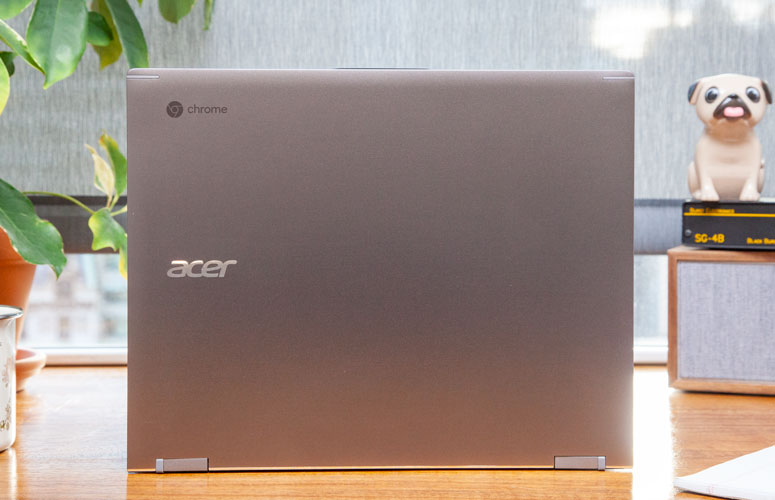
However, I gained an appreciation for the Chromebook 13's design once I gave it a closer look. For one, the Chromebook 13 is made of solid aluminum, an improvement over the plastic we often see on midrange Acer products. The chrome trim around the Chromebook 13's touchpad, deck and rear hinge provides a touch of elegance, while sharp angles on the hinge and back edge give the Chromebook 13 a more aggressive appearance.
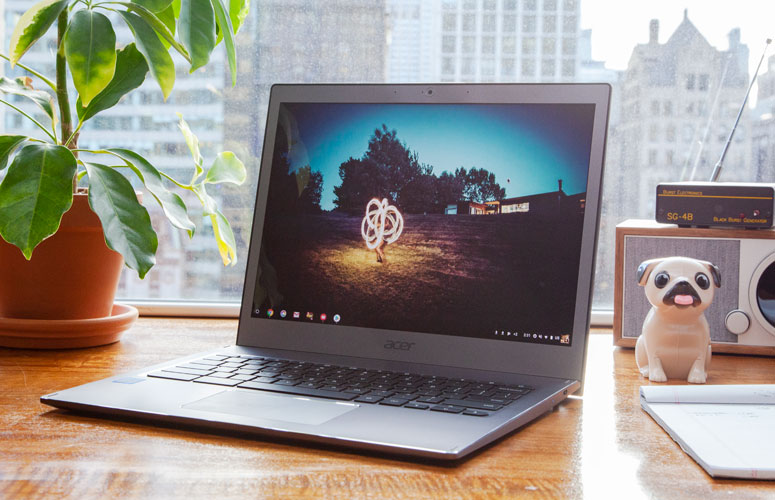
Taking a page from Asus' Ergolift hinge, the Chromebook 13 rests on its rear edge when the lid is open. This lifts the back of the keyboard off the ground a few millimeters, bringing the palm rest to a more comfortable angle and making the key font more visible. The hinge also folds back flat for presenting the display to others.
At 12.2 x 9.7 x 0.7 inches and 3.6 pounds, the Chromebook 13 is relatively portable, but competing laptops with smaller displays are predicably thinner and lighter; that includes the 12.3-inch Pixel Slate (11.5 x 8 x 0.3 inches, 2.9 pounds), the 12.3-inch Samsung Chromebook Pro (11.1 x 8.7 x 0.6 inches, 2.4 pounds) and the 12.3-inch HP Chromebook x2 (11.5 x 8.3 x 0.3 inches, 3.1 pounds).
Ports
The port selection on the Chromebook 13 is limited, but there are a few modern inputs onboard.
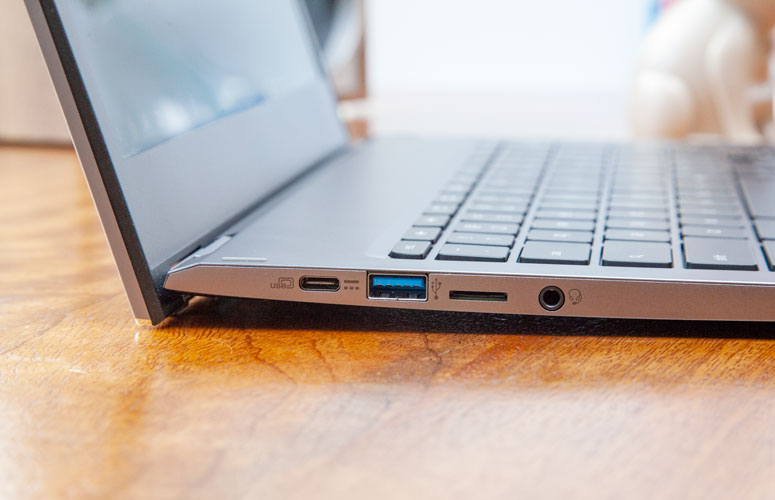
A single USB 3.1 Type-C port has the right side of the laptop to itself, while the machine's left edge holds another USB Type-C port, a USB 3.0 input, a microSD card slot and a headphone/mic jack.
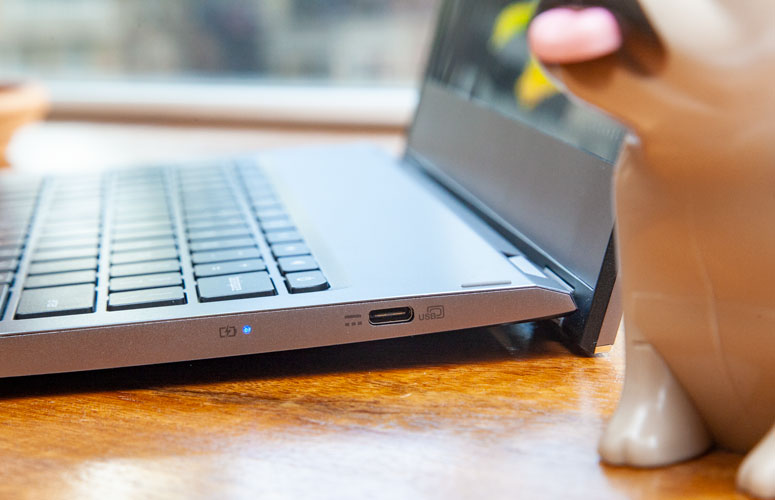
Display
The Acer Chromebook 13's 13.5-inch, 2256 x 1504-pixel display is detailed and colorful, but competing laptops get brighter.
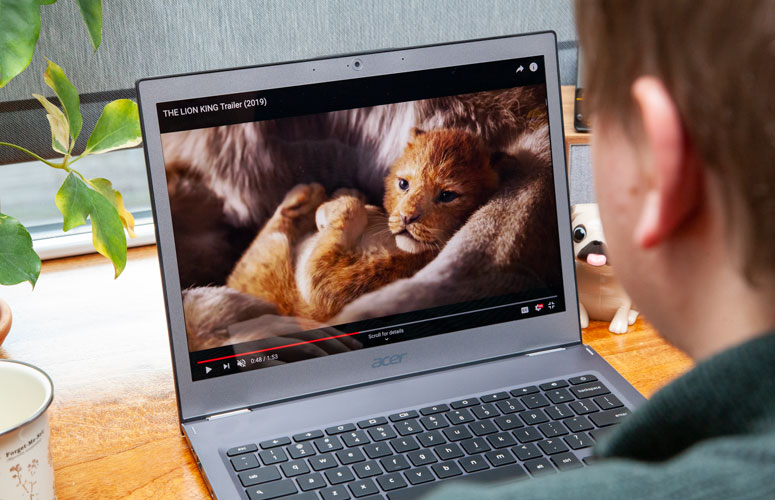
The crisp 3:2 panel gave me a detailed look at Natalie Portman's bizarre, often outlandish fashion in the trailer for her upcoming film Vox Lux. In one scene, the versatile actress, her hair painted in lucid chrome, glared into the camera with a subtly curved smile, the corners of her glitter-coated eyes glistening a rich silver as a dim light cast a glow on her character, a budding pop star.
When I browsed the web, the display exhibited accurate white balance, and even the smallest text appeared crisp.
The Acer Chromebook 13's 13.5-inch, 2256 x 1504-pixel display is detailed and colorful, but it doesn't get particularly bright.
The display is so vivid that it reproduces 126 percent of the sRGB color gamut, according to our colorimeter measurements. That makes this screen more colorful than the displays on the Pixel Slate (120 percent), Chromebook Pro (118 percent) and Chromebook x2 (114 percent), three competitors that crushed the category average (82 percent).
MORE: Laptops with the Best Display Brightness
This display has a maximum brightness of just 216 nits. The displays on the Pixel Slate (337 nits), Chromebook Pro (376 nits) and Chromebook x2 (403 nits) peaked at more than 100 nits brighter than the Chromebook 3, and even the category average (220 nits) outshines the Acer.
Note: Acer sent us a replacement review unit with a peak display brightness of 282 nits. While that tops the Chromebook category average, the panel still isn't as bright as the competition.
Keyboard and Touchpad
The keys on the Chromebook 13 are well-sized and appropriately spaced, and their 62 grams of actuation force won't slow down even the quickest of typists. But at 1.3 millimeters, the keys don't travel as much as I'd like (our preference is 1.5mm to 2mm of key travel), and the result is that I frequently bottomed down while writing this review.
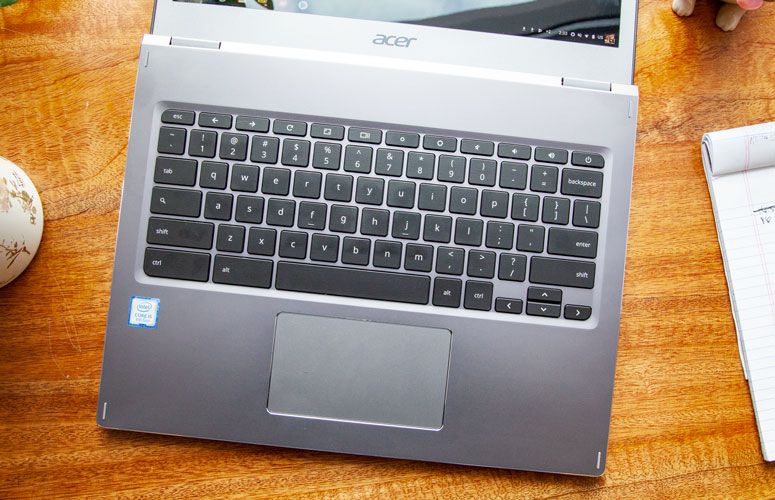
Typically, a quiet keyboard means a mushy keyboard, but the Chromebook 13's offers a small bump when keystrokes are registered, adding just enough tactile resistance.
I typed 111 words per minute at an accuracy of 91 percent on the 10fastfingers.com typing test. Those scores are worse than my typical 119-wpm rate and 95 percent accuracy.
The 4.1 x 2.3-inch Gorilla Glass touchpad is a tad sensitive out of the box, but I had no issues scrolling through Google Chrome web pages or using a two-finger click to open up the quick-access menu.
Audio
The bottom-firing speakers on the Chromebook 13 filled our small office with audio, but you'll want a Bluetooth speaker for larger venues. When I cranked Kanye West's "No Church in the Wild," legendary rapper and producer Jay-Z's vocals were hard to distinguish under muddy bass tones. That said, the speakers sounded surprisingly good once I decreased the volume to 75 percent.
MORE: 14 Cheap Headphones Ranked From Best To Worst
Chris Martin's falsetto sounded crisp and clear when I played "Hymn for the Weekend," and the the blaring electric instruments were clearly defined. Again, things went downhill once I increased the volume; Martin's vocals and the high-pitched piano chords grew piercing, to the point of being fatiguing.
Performance
With the combination of a powerful Intel Core i5-8250U processor and a streamlined OS, it's no wonder that the Chromebook 13 flew through my real-world performance test. I didn't catch the slightest bit of lag when I loaded 18 Google Chrome tabs and played four 1080p videos simultaneously. I typically run into lag when switching tabs under such a heavy workload, but the Chromebook 13 took me to my desired web page without flinching.
Combine a powerful Intel Core i5-8250U processor with a streamlined OS, and it's no wonder that the Chromebook 13 flew through my real-world performance test.
The Chromebook 13 scored a 169 on our JavaScript benchmark test, outperforming its rivals, the Pixel Slate (133.2, Core i5-8200Y), Chromebook Pro (126.6, Core m3-6Y30) and Chromebook x2 (109.6, Core m3-7Y30). The Acer more than doubled the Chromebook category average (69.3).
Mobile gamers can expect a smooth experience from the Chromebook 13, which rendered 5,000 fish at an average of 40 frames per second on the WebGL Aquarium graphics test. The Chromebook Pro did even better (48 fps), matching the Chromebook average (48 fps), while the Pixel Slate lagged far behind (28 fps), missing our 30-fps playability threshold.
Chrome OS
The Acer Chromebook 13 runs the latest version of Chrome OS, Google's desktop operating system. The OS has evolved over the years and is now recommended, to certain users, ahead of Windows and macOS.
The operating system is still centered around the Chrome browser, but recent Android app support has expanded the OS's capabilities in a big way. You can now choose from tons of apps, including all of the essentials, like Facebook, Maps, YouTube and Lyft. Take note that some apps don't run as well as others. As my colleague Henry Casey pointed out, text in the Discord messaging app is very small on this high-res display and the Lyft app just isn't scaled up from the mobile app at all.
MORE: 10 Things You Need To Know About Chrome OS
The Chrome OS home screen should be familiar to Windows users, with icons on the bottom-right corner and app shortcuts on the bottom left. Selecting the circular menu button pulls up a search box that scans through your device, apps and Google Search for whatever terms you type in. From there, you can see your recent apps and quickly pull up an app tray that's similar to what you'll find on a phone running Android Pie.
Because of its simple menus and countless apps, Chrome OS remains a recommended operating system for kids and students. But without support for third-party programs, the benefit of spending $800 on a Chromebook with powerful components remains to be seen. That puts the value proposition of a laptop like the Acer Chromebook 13 in question.
Battery Life
The Chromebook 13's battery life isn't terrible, but we've come to expect better endurance from Chromebooks. The laptop powered down after 8 hours and 15 minutes on our Laptop Mag Battery Test, which involves continuous web surfing over Wi-Fi at 150 nits of display brightness. The x2 (8:50) lasted 35 minutes longer on a charge, and the Pixel Slate (9:51) endured for nearly 10 hours. While the Chromebook 13 did outlast the Pro (8:05), it fell more than an hour short of the average for Chromebook battery life (9:26).
Webcam
The selfie I took on the Chromebook 13's front-facing camera looked more like a watercolor painting than an actual photo. My face appeared blotchy, as if I'd tried to put makeup on for the first time, without any guidance. Cameras sometimes intentionally produce smeared images to reduce visual noise, but this 720p lens somehow retained those poor characteristics. The lights behind me were so blown out that it reminded me of the harsh sensation you get when you look into the sun on a bright day.
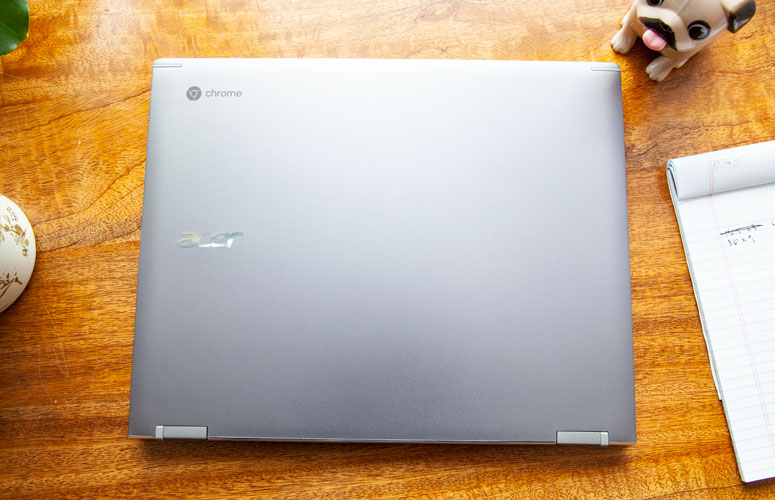
To its credit, the camera accurately captured the subtle difference in color between my forest-green sweater and my medium-green T-shirt. Still, do yourself a favor and spend a few extra bucks on an external webcam.
Heat
The Chromebook 13 remained at a comfortable temperature after we played a 15-minute HD video in full screen. The touchpad (79 degrees Fahrenheit) didn't go much above room temperature, while the center of the keyboard (82 degrees) and the underside (87 degrees) of the laptop also remained under our 95-degree comfort threshold. Even the hottest location, near the hinge, warmed to only 92 degrees.
Bottom Line
The Acer Chromebook 13 is a capable laptop that offers excellent performance in a sleek aluminum package. The 13.5-inch display is crisp and vivid, and the laptop stayed cool under a heavy workload. If the Chromebook 13's runtime was extended a few hours, then this portable laptop would be the undisputed king of the growing premium-Chromebook segment. Nonetheless, the Chromebook 13 is a very good option -- unless, of course, you need a touch screen.
Google's own Pixel Slate is one of the best premium Chromebooks with touch support. This convertible tablet has a gorgeous display, a surprisingly comfortable optional keyboard and almost 10 hours of battery life. Be warned, however, that we ran into some troubling Bluetooth issues when using the 12.3-inch Slate. The Samsung Chromebook Pro is another good alternative to the Chromebook 13. It, too, has a beautiful display and stylish chassis, but a mushy keyboard prevents that machine from serving as a good laptop replacement.
The verdict is still out on whether you should pay a premium for a Chromebook, but if you've committed to doing so, the Acer Chromebook 13 is one to consider.
Credit: Laptop Mag
Acer Chromebook 13 (2018) Specs
| Bluetooth | Bluetooth 4.2 |
| Brand | Acer |
| CPU | Intel Core i5-8250U |
| Card Slots | microSD |
| Company Website | https://www.acer.com/worldwide/selection.html |
| Display Size | 13.5 |
| Graphics Card | Intel UHD Graphics 620 |
| Hard Drive Size | 64GB |
| Hard Drive Type | eMMC |
| Highest Available Resolution | 2256 x 1504 |
| Native Resolution | 2256 x 1504 |
| Operating System | Windows 10 Home |
| Ports (excluding USB) | USB 3.1 with Type-C, Headphone/Mic, microSD, USB 3.0 |
| RAM | 8GB |
| Size | 12.2 x 9.7 x 0.7 inches |
| Touchpad Size | 4.1 x 2.3 inches |
| USB Ports | 3 |
| Warranty/Support | One-year warranty. |
| Weight | 3.6 pounds |
| Wi-Fi | 802.11a/b/g/n/ac |
Phillip Tracy is the assistant managing editor at Laptop Mag where he reviews laptops, phones and other gadgets while covering the latest industry news. After graduating with a journalism degree from the University of Texas at Austin, Phillip became a tech reporter at the Daily Dot. There, he wrote reviews for a range of gadgets and covered everything from social media trends to cybersecurity. Prior to that, he wrote for RCR Wireless News covering 5G and IoT. When he's not tinkering with devices, you can find Phillip playing video games, reading, traveling or watching soccer.

